Miso Salmon Bowl
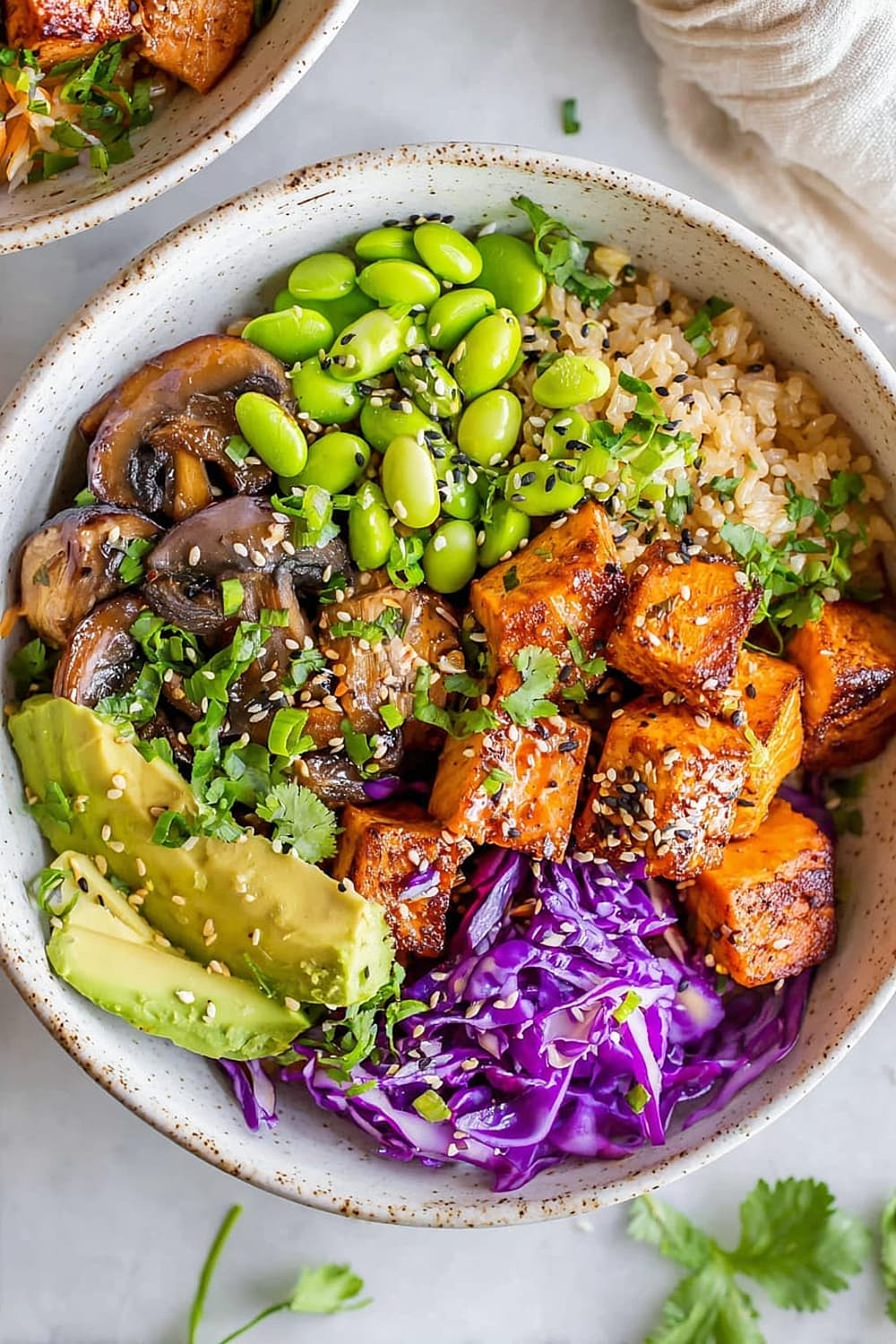
This recipe is basically what happens when Asian flavors meet your desperate need to eat something that makes you feel like a functioning adult.
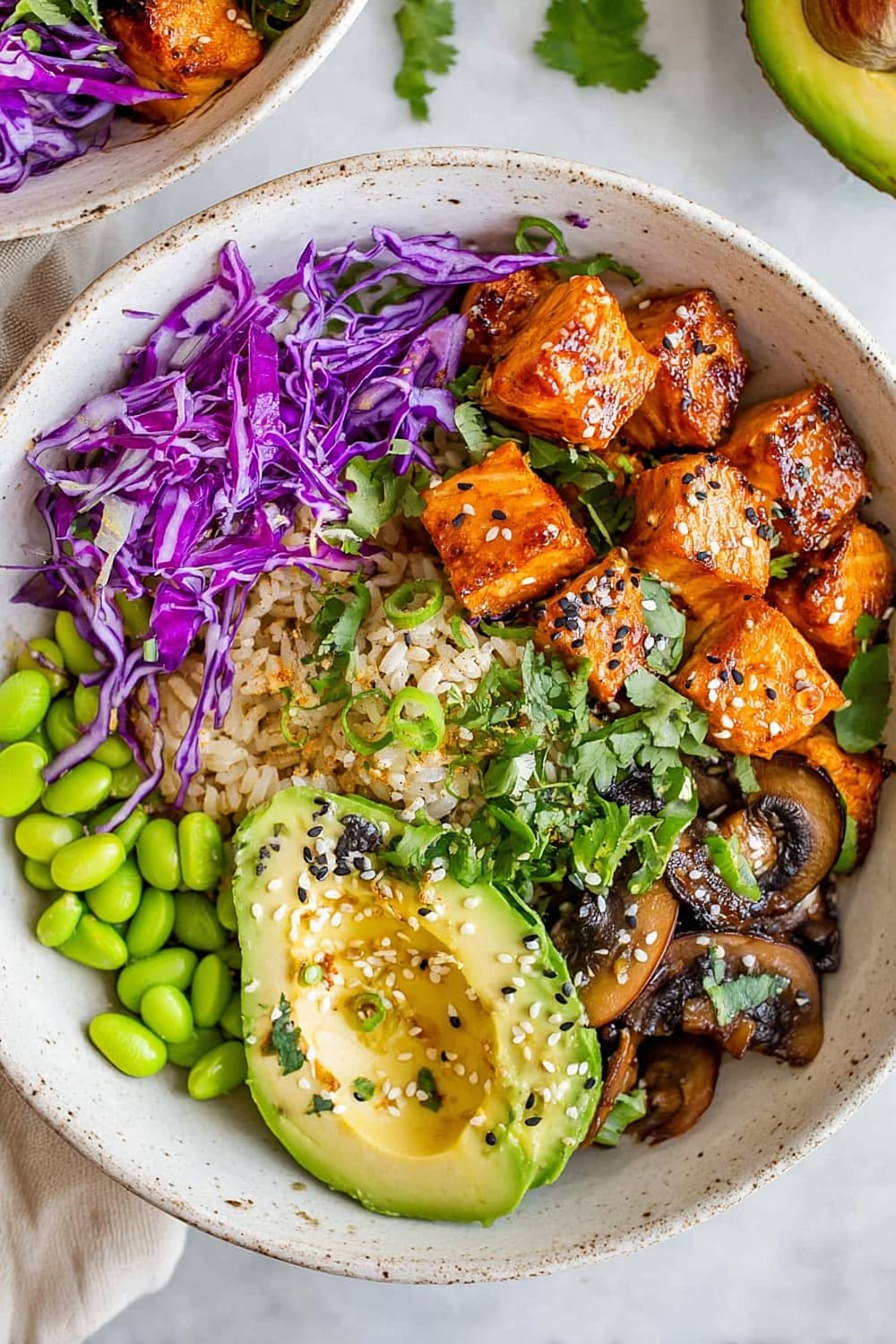
One bite of this perfectly seasoned salmon with that silky miso dressing and you’ll be convinced you’ve unlocked some kind of culinary cheat code.
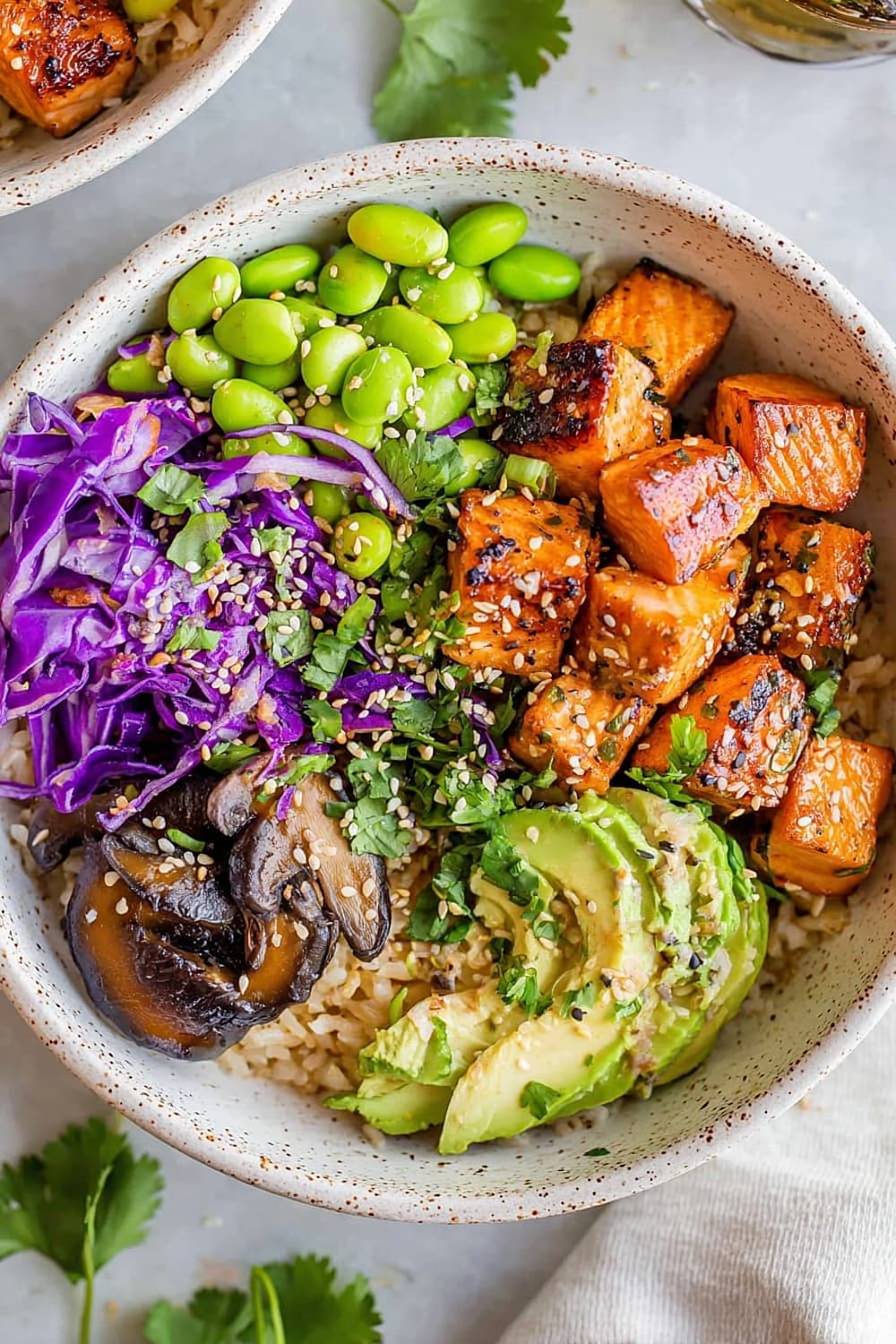
The combination of crispy-edged salmon bites, earthy roasted shiitakes, and creamy avocado creates this perfect harmony that somehow makes eating vegetables feel like a celebration instead of a chore.
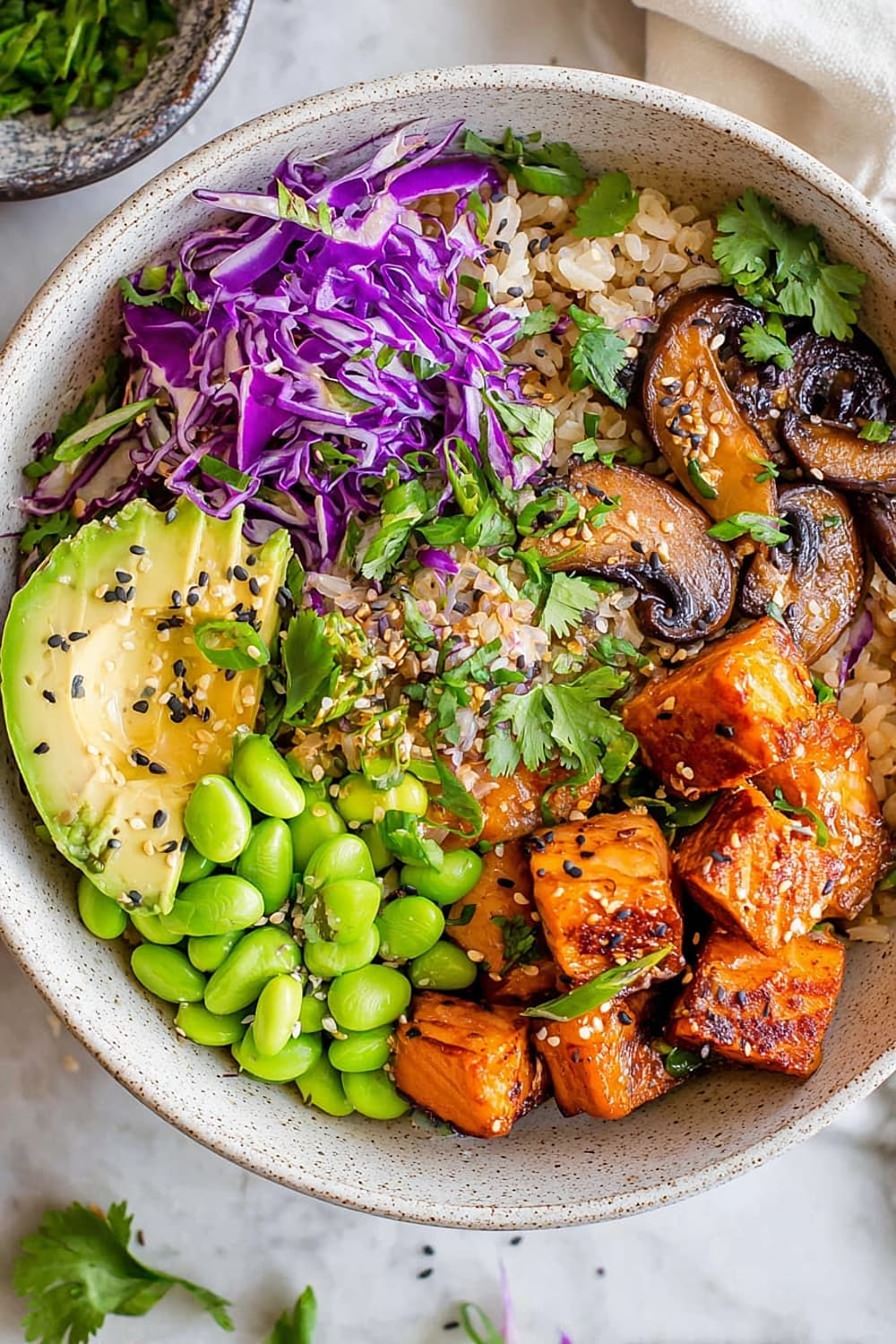
What makes this bowl absolutely genius is how the umami-packed miso dressing ties everything together – it’s like the conductor of a very delicious orchestra where every ingredient actually knows its part.
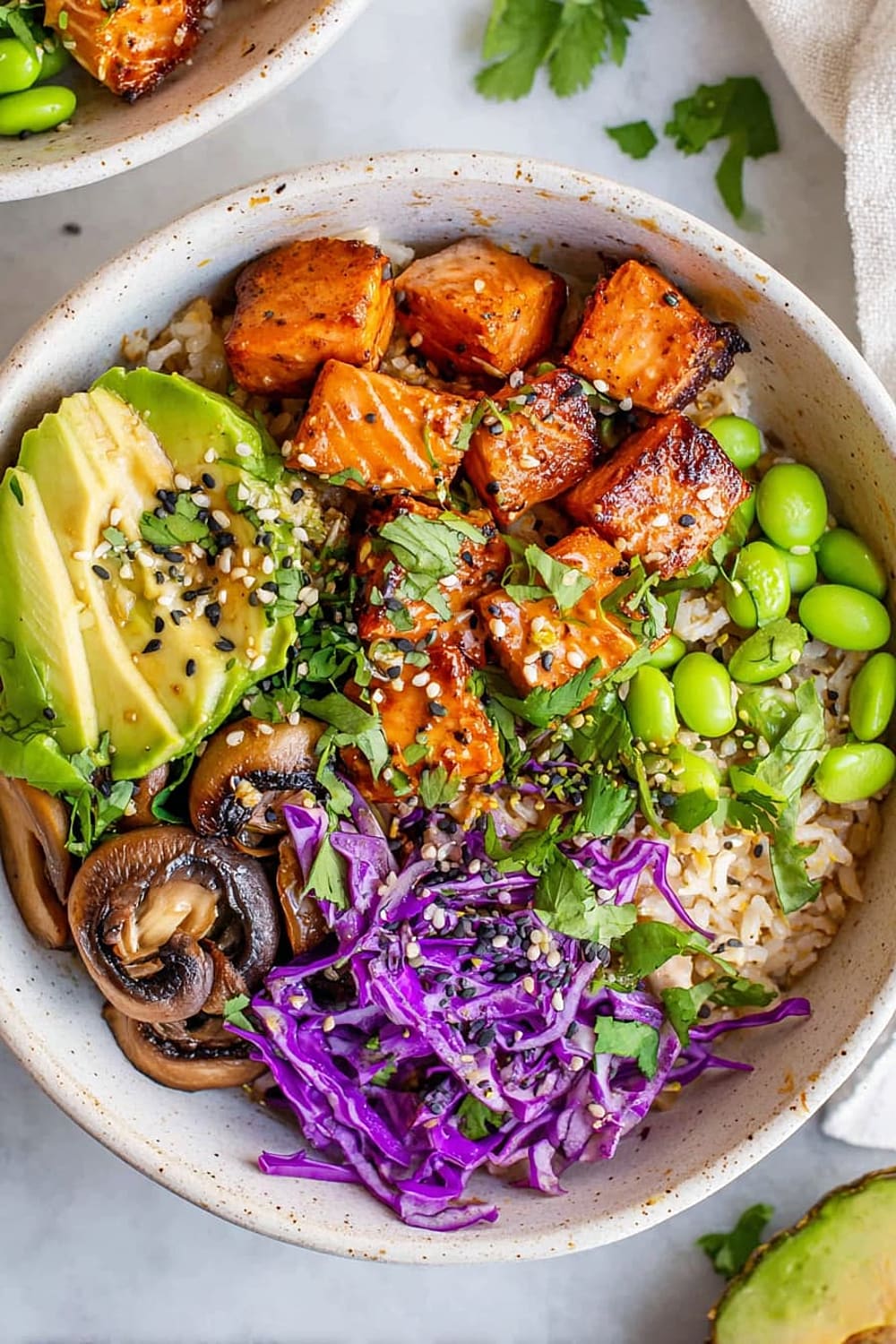
Plus, this is the kind of meal that photographs beautifully but doesn’t require you to stress-sweat through complicated techniques or hunt down impossible-to-find ingredients.
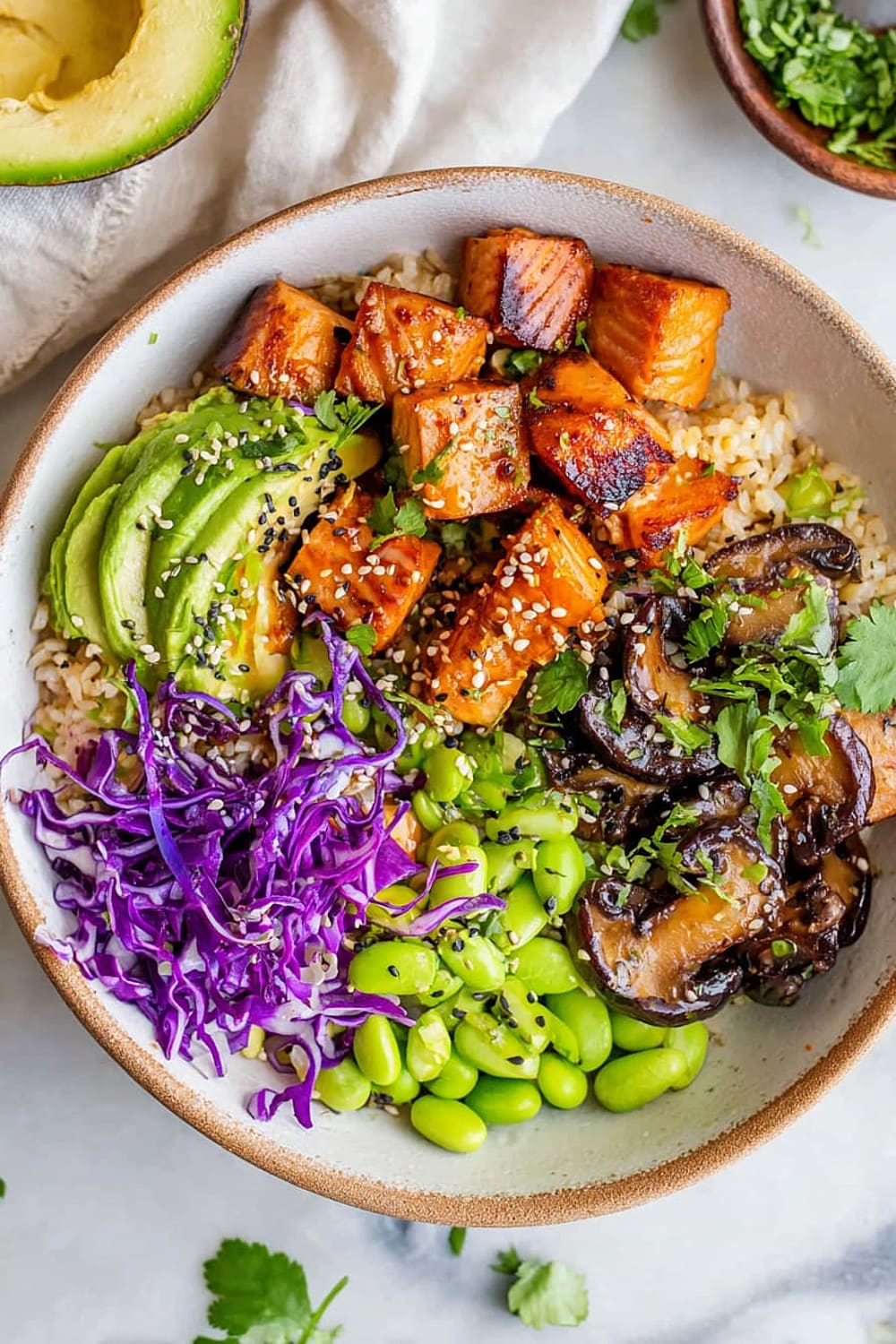
Whether you’re meal prepping for the week or trying to impress someone with your surprisingly sophisticated palate, these bowls deliver that restaurant-quality experience right from your own kitchen.
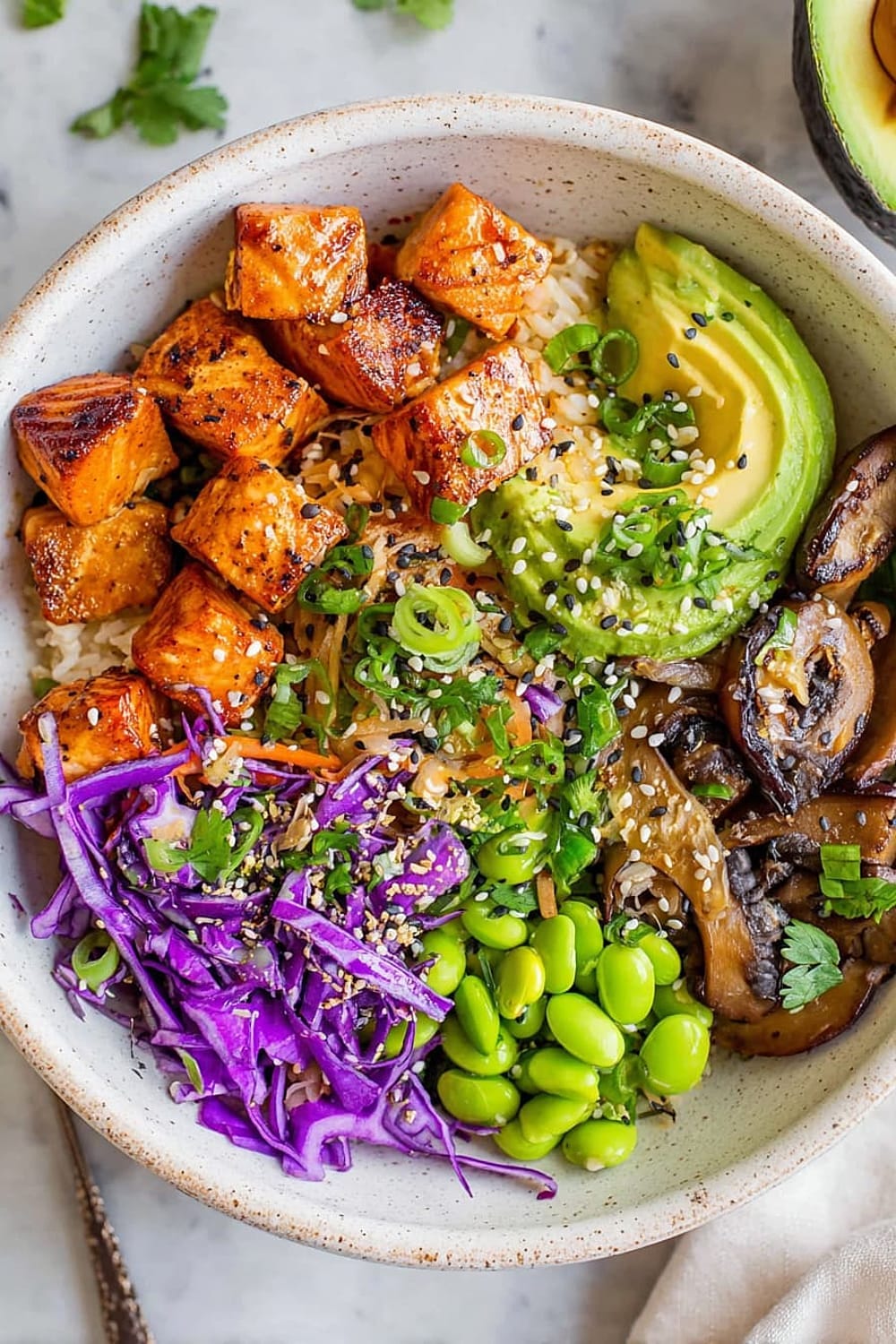
Ingredients
For the Salmon Bites
- 1 pound salmon fillets, fully thawed (choose fillets that are even in thickness, skin off or peel off after cooked)
- 1 /4 teaspoon 5-spice powder
- 1 /4 to 1/2 teaspoon salt (adjust to taste)
- 1 /2 teaspoon garlic powder
- 1 /2 teaspoon onion powder
- 1 /2 teaspoon ground ginger
- 1 /2 teaspoon black pepper
- 1 /8 to 1/4 teaspoon cayenne pepper
- 1 teaspoon sugar
For the Bowl Components
- 3-4 cups cooked rice (brown rice, jasmine rice, black rice, or other cooked grain, or cauliflower rice)
- 2 cups (8 ounces) fresh shiitake mushrooms
- 2 cups edamame, shelled and thawed
- 1 large avocado
- 2 cups red cabbage, shredded
- Optional garnishes: sesame seeds, cilantro, scallions, microgreens, chili crisp, or peanut chili crunch
For the Miso Dressing
- 1 /4 cup olive oil
- 3 tablespoons sesame oil
- 3 tablespoons rice vinegar
- 3 tablespoons maple syrup (or honey)
- 2 tablespoons miso paste
- 2 tablespoons soy sauce or Bragg’s Liquid Aminos
- 2 tablespoons water
- 1 small garlic clove
- 2 teaspoons fresh ginger, sliced
- 1 /4 teaspoon salt
- Pinch cayenne pepper
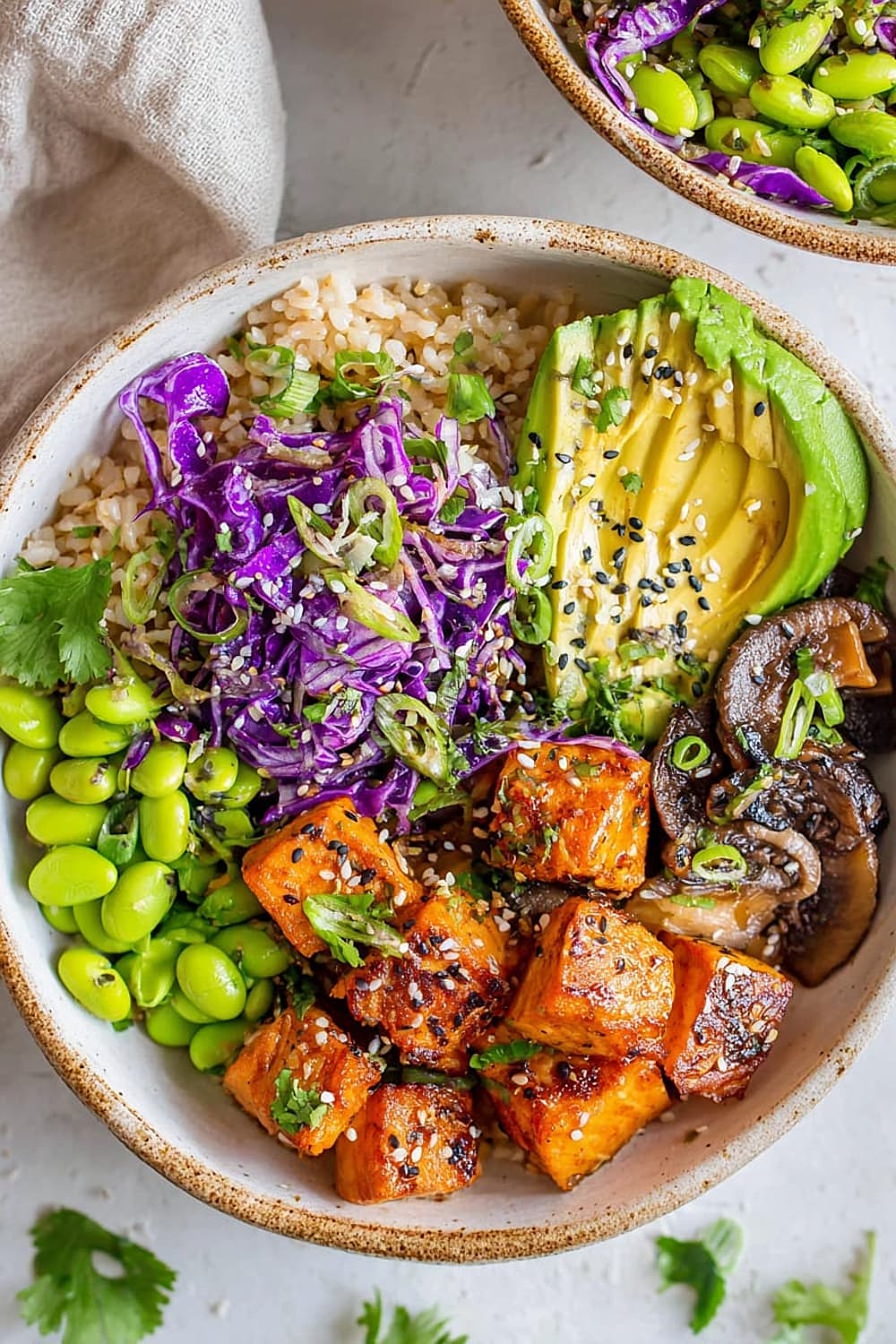
Instructions
Preparation
- 1 Set rice to cook according to package directions. For perfectly fluffy jasmine rice, use a 1:1.5 ratio of rice to water and bring to a boil, then reduce heat to low, cover, and simmer for 18 minutes.
- 2 Place all miso dressing ingredients in a high-speed blender and blend until silky smooth, about 60-90 seconds. The dressing should be completely emulsified with no visible ginger or garlic pieces remaining.
Prepare the Vegetables
- 3 Preheat your oven to 450°F (232°C) and line a baking sheet with parchment paper. Remove woody stems from shiitake mushrooms and brush caps generously with some of the prepared miso dressing.
- 4 Arrange shiitakes in a single layer on the prepared baking sheet, ensuring they don’t overlap. Roast for 15-20 minutes depending on mushroom size, until edges are golden and slightly crispy.
Season and Cook the Salmon
- 5 In a small mixing bowl, combine 5-spice powder, salt, garlic powder, onion powder, ginger, black pepper, cayenne, and sugar. Mix thoroughly to create an even spice blend.
- 6 Pat salmon fillets completely dry with paper towels to remove excess moisture, which ensures better spice adhesion and crispier results. Cut salmon into 1-inch cubes, keeping pieces as uniform as possible for even cooking.
- 7 Gently toss salmon cubes in the spice mixture, stirring carefully until each piece is fully coated. Don’t press too hard as this can break the delicate fish.
- 8 Preheat your air fryer to 400°F (204°C). Arrange seasoned salmon pieces on the air fryer rack with space between each piece to allow proper air circulation. Work in two batches if necessary to avoid overcrowding.
- 9 Spray salmon lightly with olive oil for extra crispiness (optional but recommended). Air fry for 3 minutes, then carefully turn each piece and cook for 2 minutes more. Internal temperature should reach 125°F (52°C) – remember, salmon continues cooking as it rests.
Assembly and Serving
- 10 Divide warm rice evenly between four shallow bowls, creating a base layer. Shallow bowls work best for this recipe as they showcase all the colorful components beautifully.
- 11 Arrange roasted shiitakes, edamame, sliced avocado, shredded red cabbage, and cooked salmon in separate sections over the rice, creating an aesthetically pleasing rainbow of colors and textures.
- 12 Drizzle 2-3 tablespoons of miso dressing over each bowl, making sure to coat all components including the salmon. The dressing should lightly coat everything without pooling at the bottom.
- 13 Garnish with fresh cilantro, sliced green onions, toasted sesame seeds, and a sprinkle of chili flakes or a drizzle of sriracha for heat lovers.
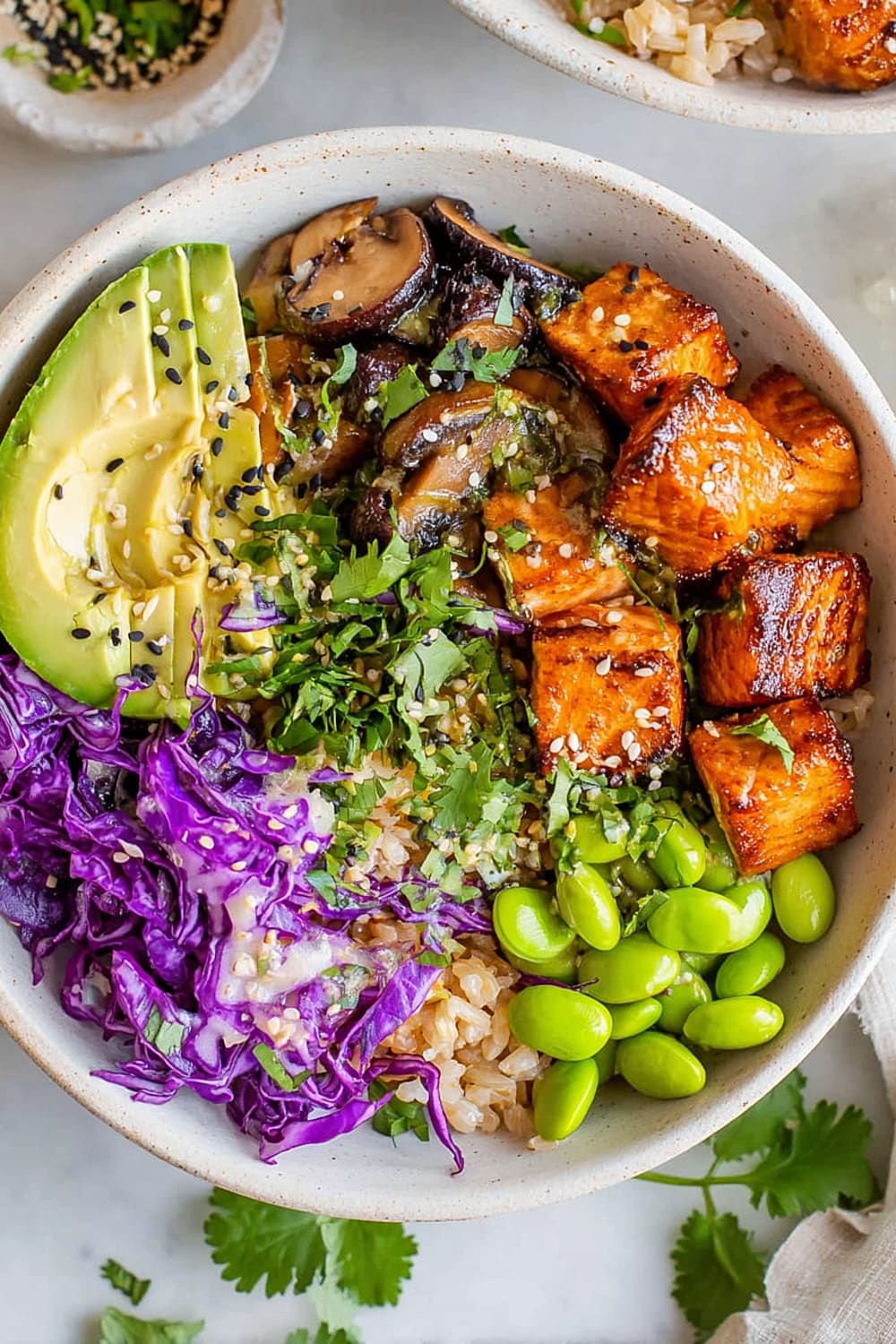
Recommended Equipment and Kitchen Tools
Recommended Tools (for best results)
- High-speed blender – Essential for creating that perfectly smooth, emulsified miso dressing without any gritty texture from the ginger or garlic
- Air fryer – Gives salmon the ideal crispy exterior while keeping the interior tender and flaky, though oven and stovetop methods work too
- Sharp chef’s knife – Critical for cutting uniform salmon cubes that cook evenly and creating clean, precise vegetable cuts
- Instant-read thermometer – Takes the guesswork out of salmon doneness, ensuring perfectly cooked fish every time
Helpful Upgrades
- Kitchen scale – For precise salmon portioning and consistent results when meal prepping multiple batches
- Mandoline slicer – Creates perfectly thin, uniform cabbage shreds that look restaurant-professional
- Cast iron skillet – If you prefer pan-searing your salmon, cast iron provides excellent heat retention and beautiful caramelization
- Microplane grater – For fresh ginger preparation, though pre-sliced works fine for the blender method
Nice-to-Have Options
- Rice cooker – Eliminates any guesswork for perfectly cooked rice every time, freeing you up to focus on other components
- Silicone spatula – Gentle enough for turning delicate salmon pieces without breaking them apart
- Shallow serving bowls – Presentation matters, and wide, shallow bowls showcase all the beautiful colors and textures
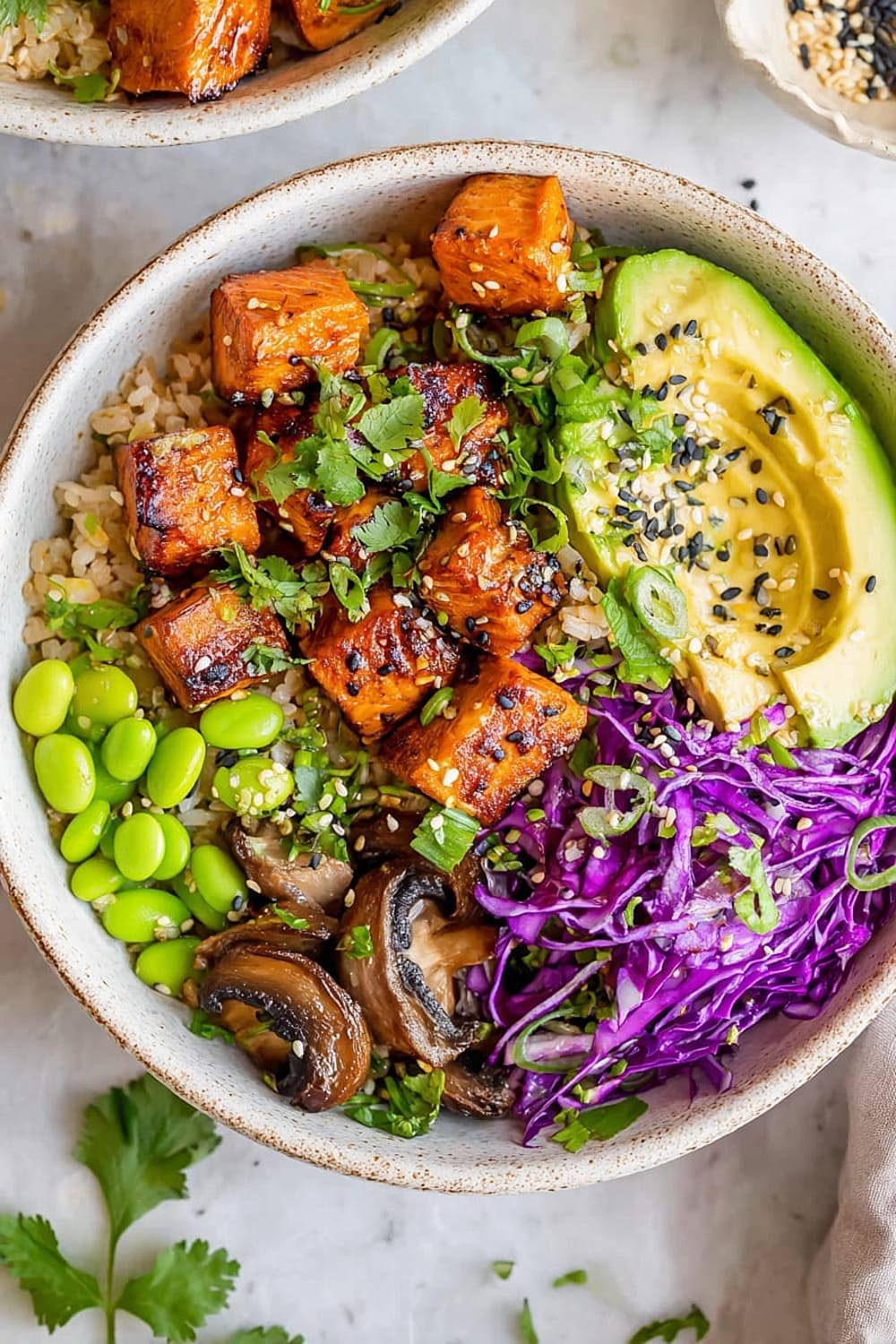
Recipe Variations and Dietary Modifications
Gluten-Free Adaptation
- This recipe is naturally gluten-free when using tamari or gluten-free soy sauce instead of regular soy sauce
- Verify that your miso paste is gluten-free, as some varieties contain wheat
- Use certified gluten-free 5-spice powder or make your own blend
Dairy-Free Modifications
- Recipe is already completely dairy-free as written
- All oils used are plant-based
- Ensure any garnishes like chili crisp don’t contain dairy
Vegan Modifications
- Replace salmon with 1 pound extra-firm tofu, pressed and cubed, using the same spice blend
- Substitute maple syrup for honey in the dressing
- Add 1 tablespoon nutritional yeast to the spice blend for extra umami depth
- Consider marinated tempeh as another protein alternative
Low-Carb/Keto Version
- Replace rice with cauliflower rice, spiralized vegetables, or shiitake mushroom “rice”
- Reduce maple syrup in dressing to 1 tablespoon and add stevia to taste
- Increase avocado portion and add hemp seeds for healthy fats
- Net carbs drop from approximately 45g to under 15g per serving
Flavor Variations
- Korean-inspired: Add gochujang to the dressing and garnish with kimchi
- Thai twist: Include lime juice in dressing and garnish with fresh mint and crushed peanuts
- Mediterranean fusion: Replace miso with tahini and add cucumber and cherry tomatoes
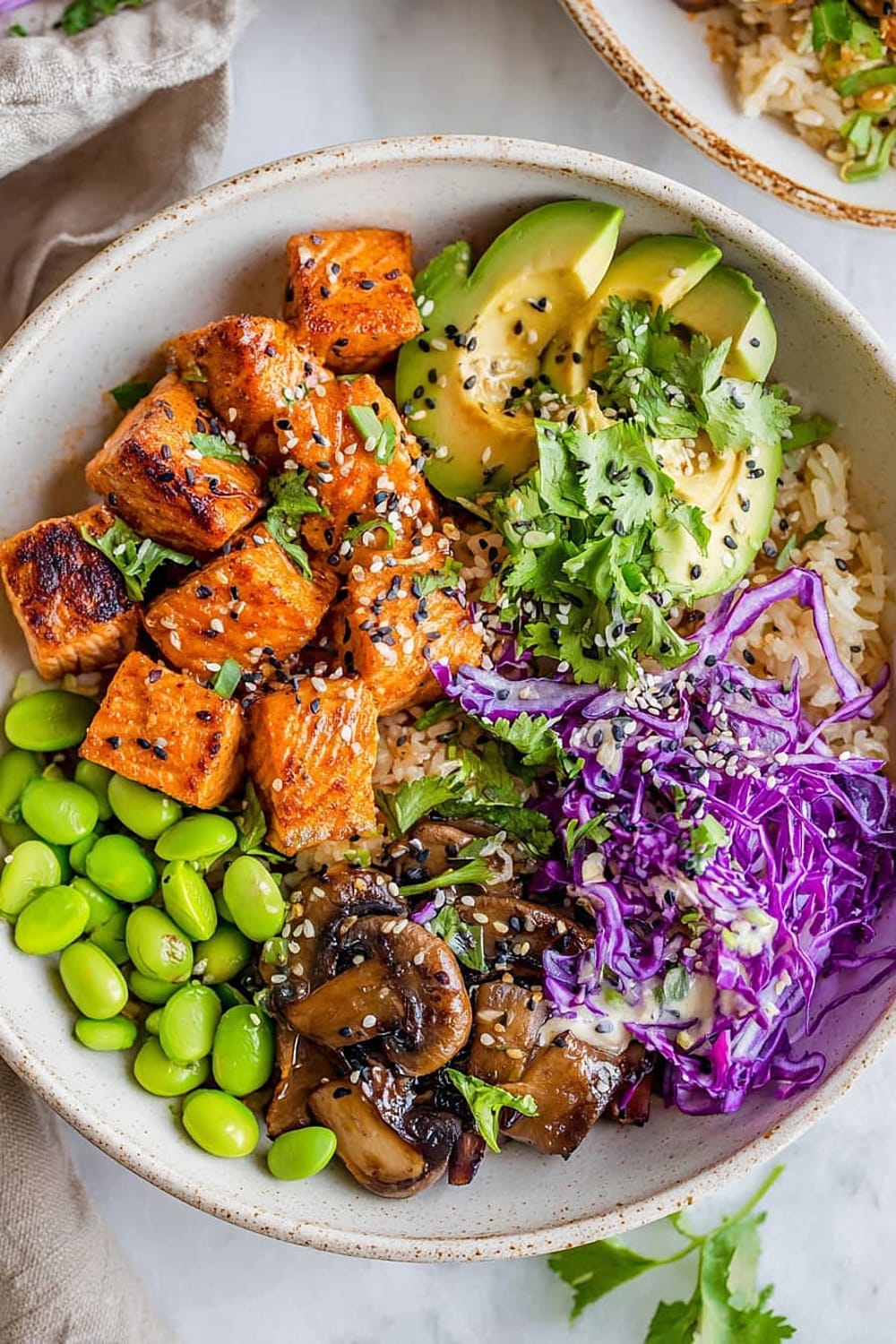
Nutritional Information and Health Benefits
Key Nutritional Highlights
This miso salmon bowl delivers approximately 520 calories per serving with an excellent macronutrient balance of 35g protein, 22g healthy fats, and 45g complex carbohydrates. The combination provides sustained energy without the crash associated with processed foods. Each serving contains approximately 8g fiber from the vegetables and brown rice, supporting digestive health and satiety. The omega-3 fatty acids from salmon provide 1.8g per serving, exceeding daily recommended amounts for heart and brain health.
Health Benefits of Main Ingredients
Wild-caught salmon provides complete protein with all essential amino acids, plus EPA and DHA omega-3s that reduce inflammation and support cardiovascular health. Miso paste contains beneficial probiotics that support gut health and immune function, while also providing B vitamins and minerals. Shiitake mushrooms offer beta-glucans that boost immune function and contain compounds that may help lower cholesterol. Edamame provides plant-based protein, folate, and vitamin K, while red cabbage delivers anthocyanins with powerful antioxidant properties. The avocado contributes heart-healthy monounsaturated fats that enhance absorption of fat-soluble vitamins from other ingredients.
Dietary Considerations
Contains soy (miso, soy sauce, edamame) and fish. Naturally gluten-free when using tamari. Suitable for pescatarian, Mediterranean, and anti-inflammatory diets. The balanced macronutrient profile makes it appropriate for active individuals and those managing blood sugar levels. One serving provides 40% daily vitamin C, 25% daily vitamin K, and significant amounts of vitamin B12, selenium, and potassium.
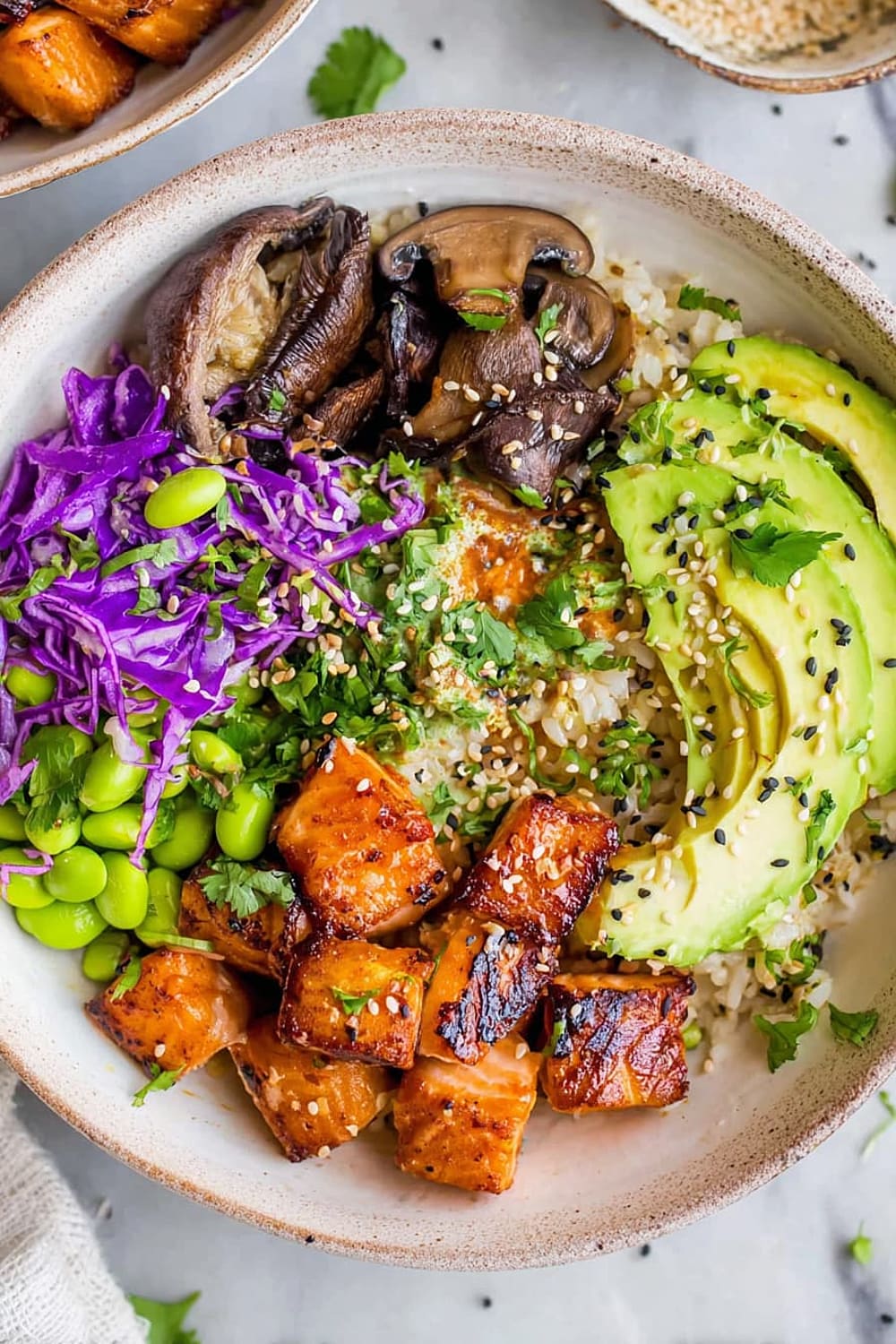
Smart Swaps and Ingredient Substitutions
Common Substitutions:
- Salmon → Arctic char, steelhead trout, or firm white fish like halibut (adjust cooking time slightly)
- Miso paste → Tahini mixed with soy sauce, or fermented black bean paste for different umami depth
- Shiitake mushrooms → Cremini, oyster, or portobello mushrooms work well with similar roasting times
- Edamame → Lima beans, sugar snap peas, or cucumber for crunch without cooking
Budget-Friendly Swaps:
- Wild salmon → Responsibly farmed salmon or frozen salmon fillets (thaw completely first)
- Fresh shiitakes → Dried shiitakes rehydrated in warm water, or mixed mushroom medley
- Sesame oil → Reduce to 1 tablespoon and supplement with additional olive oil
- Fresh ginger → 1/2 teaspoon ground ginger, though fresh provides better flavor
Pantry Emergency Substitutions:
- Rice vinegar → Apple cider vinegar or white wine vinegar with a pinch of sugar
- 5-spice powder → Mix of cinnamon, star anise, fennel, cloves, and Sichuan peppercorns
- Maple syrup → Honey, agave nectar, or brown sugar dissolved in warm water
- Fresh avocado → Sliced cucumber or steamed broccoli for different but satisfying results
Pro Tips for Substitutions:
- When using frozen salmon, thaw overnight in refrigerator and pat extra dry before seasoning
- Store leftover miso dressing in refrigerator for up to one week – it’s excellent on salads and roasted vegetables
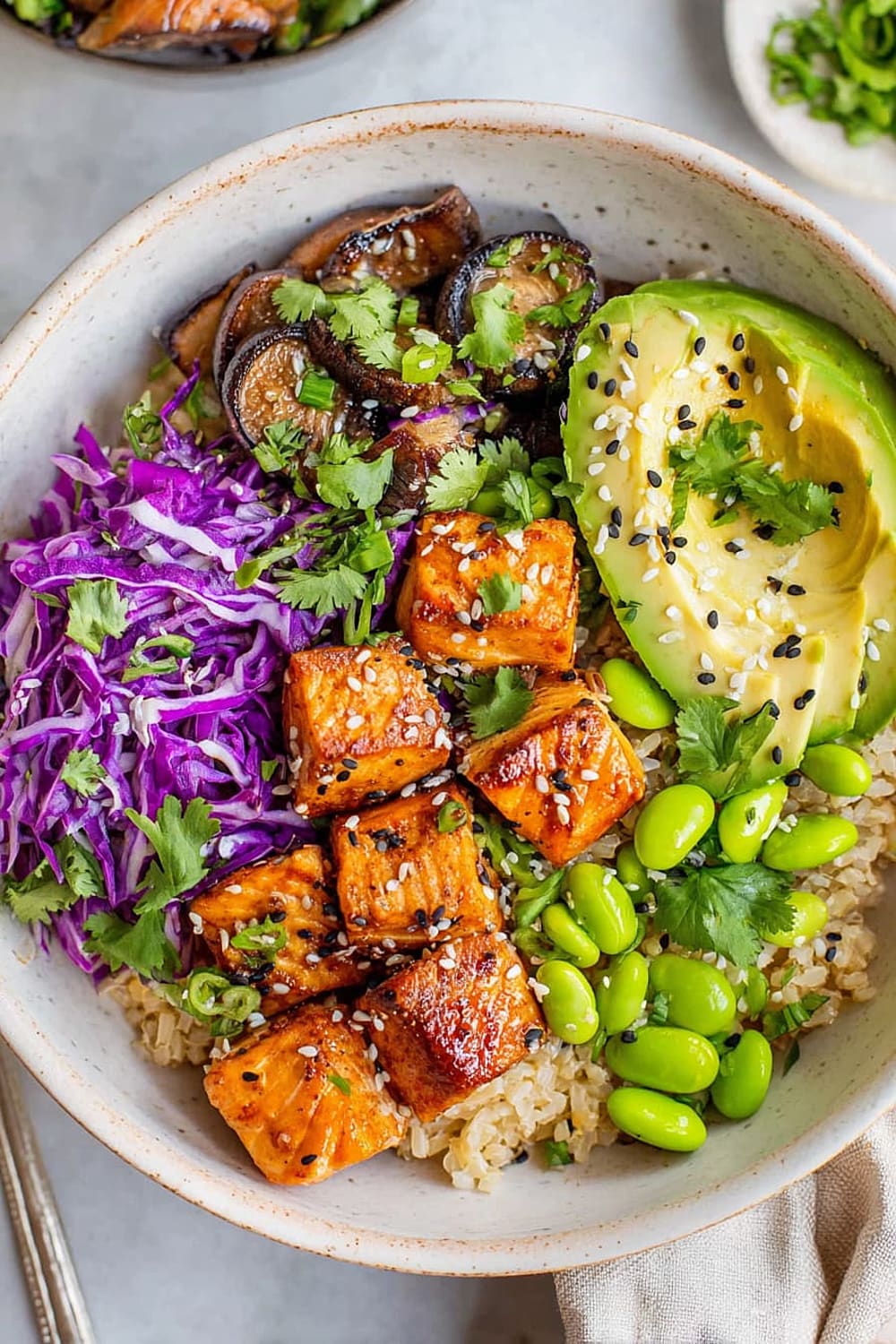
Make It Diabetes-Friendly
Carbohydrate Modifications:
- Replace regular rice with cauliflower rice to reduce carbs from 45g to 15g per serving
- Use shiitake mushroom caps as additional “rice” substitute, finely chopped and sautéed
- Increase protein portion to 6 ounces salmon per serving to improve satiety and blood sugar response
- Double the non-starchy vegetable portions (cabbage, edamame) for added fiber and nutrients
Sugar Substitutions:
- Replace 3 tablespoons maple syrup with 1 tablespoon sugar-free maple syrup plus 1/2 teaspoon stevia
- This reduces added sugars from 12g to 2g per serving
- Alternative: Use 2 tablespoons unsweetened applesauce plus stevia to taste
- The natural sweetness from miso paste helps balance the reduced sweeteners
Portion & Timing Tips:
- Stick to 1 cup total grain/starch per serving (cauliflower rice or small portion regular rice)
- Pair with 1 tablespoon healthy fats (avocado, nuts, seeds) to slow glucose absorption
- Estimated total carbs: 18-22g per modified serving versus 45g in original
- Ideal as lunch or dinner, allowing 3-4 hours between meals for optimal blood sugar management
Blood Sugar Impact:
- Modified version has estimated glycemic load of 8-10 (low) versus 18-20 (medium) for original
- High protein and healthy fat content helps maintain steady glucose levels for 3-4 hours
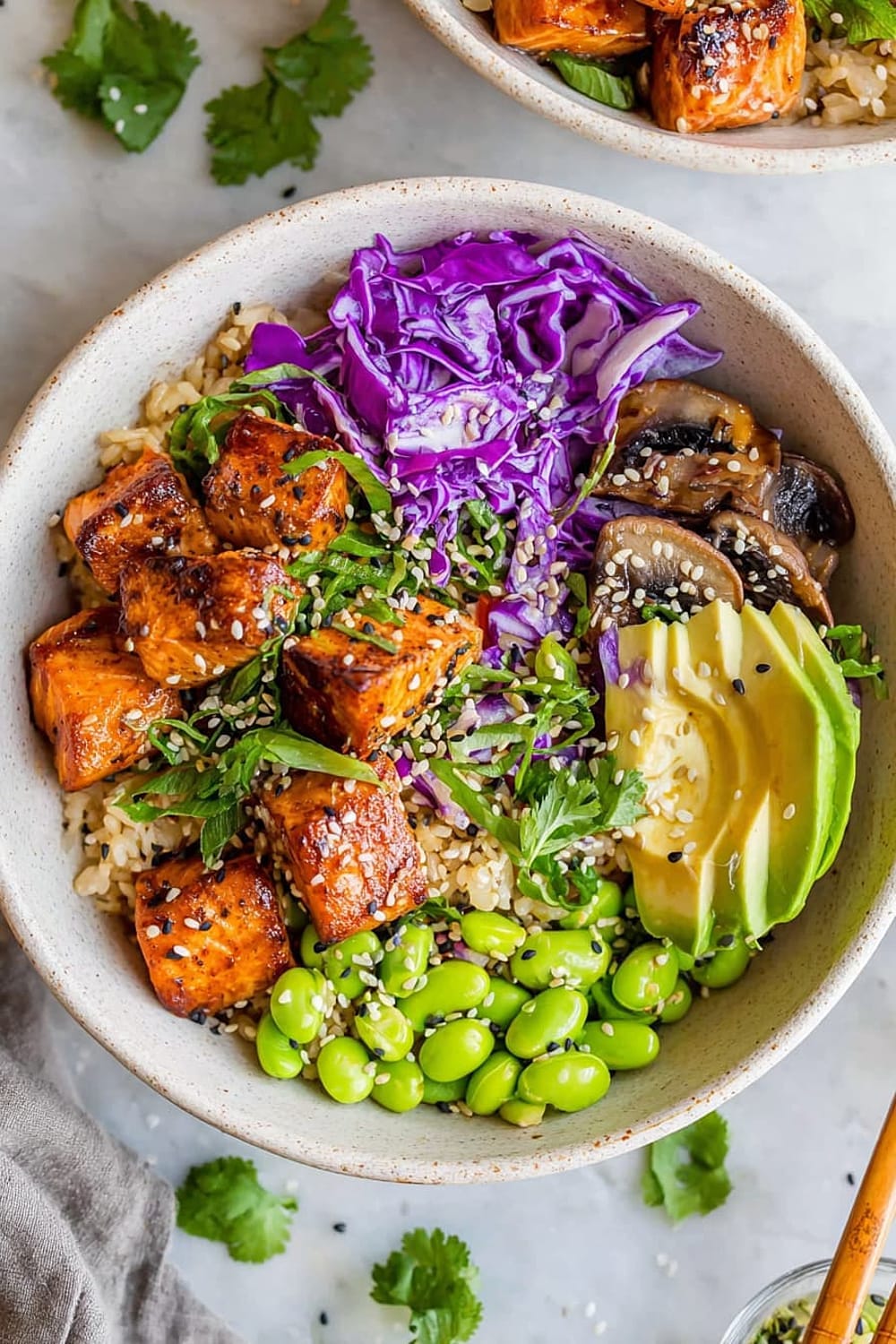
Perfect Pairing Suggestions
Beverage Pairings
A crisp Sauvignon Blanc or Pinot Grigio complements the umami richness without overwhelming the delicate salmon flavors. For beer lovers, a Japanese lager or wheat beer provides clean, refreshing contrast to the savory miso elements. Green tea or jasmine tea creates an authentic Asian dining experience, while sparkling water with lime cleanses the palate between bites. Cold-brew coffee surprisingly pairs well due to its smooth, less acidic profile that doesn’t compete with the complex flavors.
Side Dish Recommendations
Miso soup with wakame seaweed creates a cohesive Japanese-inspired meal while adding warming comfort. Cucumber sunomono (Japanese cucumber salad) provides cooling contrast and additional probiotics. Roasted Brussels sprouts with sesame oil bridge the gap between Asian and Western flavors. Pickled vegetables add acidic brightness that cuts through the rich salmon and creamy avocado textures.
Complete Meal Ideas
Start with edamame as an appetizer, serve the salmon bowls as the main course, and finish with mochi ice cream or fresh fruit for a light, satisfying conclusion. For entertaining, create a DIY bowl bar with various toppings, allowing guests to customize their portions. The bowls work beautifully for casual weeknight dinners or more formal occasions when plated individually with artistic garnish arrangements.
Occasion Suggestions
Perfect for meal prep Sundays, date night at home, or healthy family dinners. The colorful presentation makes it ideal for spring and summer entertaining when fresh ingredients are at their peak. Excellent choice for post-workout meals due to the high protein and complex carbohydrate combination.

Pro Tips and Troubleshooting
Professional Techniques
Pat salmon completely dry and let it come to room temperature for 15 minutes before cooking – this ensures even cooking and better spice adhesion. When air frying, don’t overcrowd the basket; proper air circulation is crucial for achieving crispy edges. For the miso dressing, blend on high speed for a full 90 seconds to achieve restaurant-quality smoothness. Toast sesame seeds in a dry pan for 2-3 minutes until golden for maximum flavor impact.
Common Mistakes and Solutions
Overcooked salmon is the biggest pitfall – remember it continues cooking after removal from heat, so slightly underdone is perfect. If your miso dressing separates, re-blend with an additional tablespoon of warm water. Soggy vegetables result from not patting ingredients dry; always drain edamame thoroughly and pat avocado slices gently. When meal prepping, store dressing separately and add just before eating to maintain optimal textures.
Storage and Reheating
Assembled bowls keep in the refrigerator for 3 days, though avocado should be added fresh daily. Store components separately for best results – rice and salmon can be gently reheated, while vegetables are excellent cold. Freeze cooked salmon for up to 2 months; thaw overnight and serve cold over fresh ingredients. The miso dressing actually improves in flavor after 24 hours as ingredients meld.
Scaling and Presentation
Double the recipe easily for meal prep or entertaining – just cook salmon in batches to avoid overcrowding. For elegant presentation, use a ring mold to create perfect rice circles, then arrange toppings in color-coordinated sections. Garnish with microgreens and black sesame seeds for restaurant-style plating that photographs beautifully.
This miso salmon bowl proves that eating well doesn’t require complicated techniques or exotic ingredients – just quality components treated with respect and combined thoughtfully. The result is a meal that satisfies both your nutritional needs and your desire for something that tastes absolutely incredible, making healthy eating feel like the delicious choice it should always be.
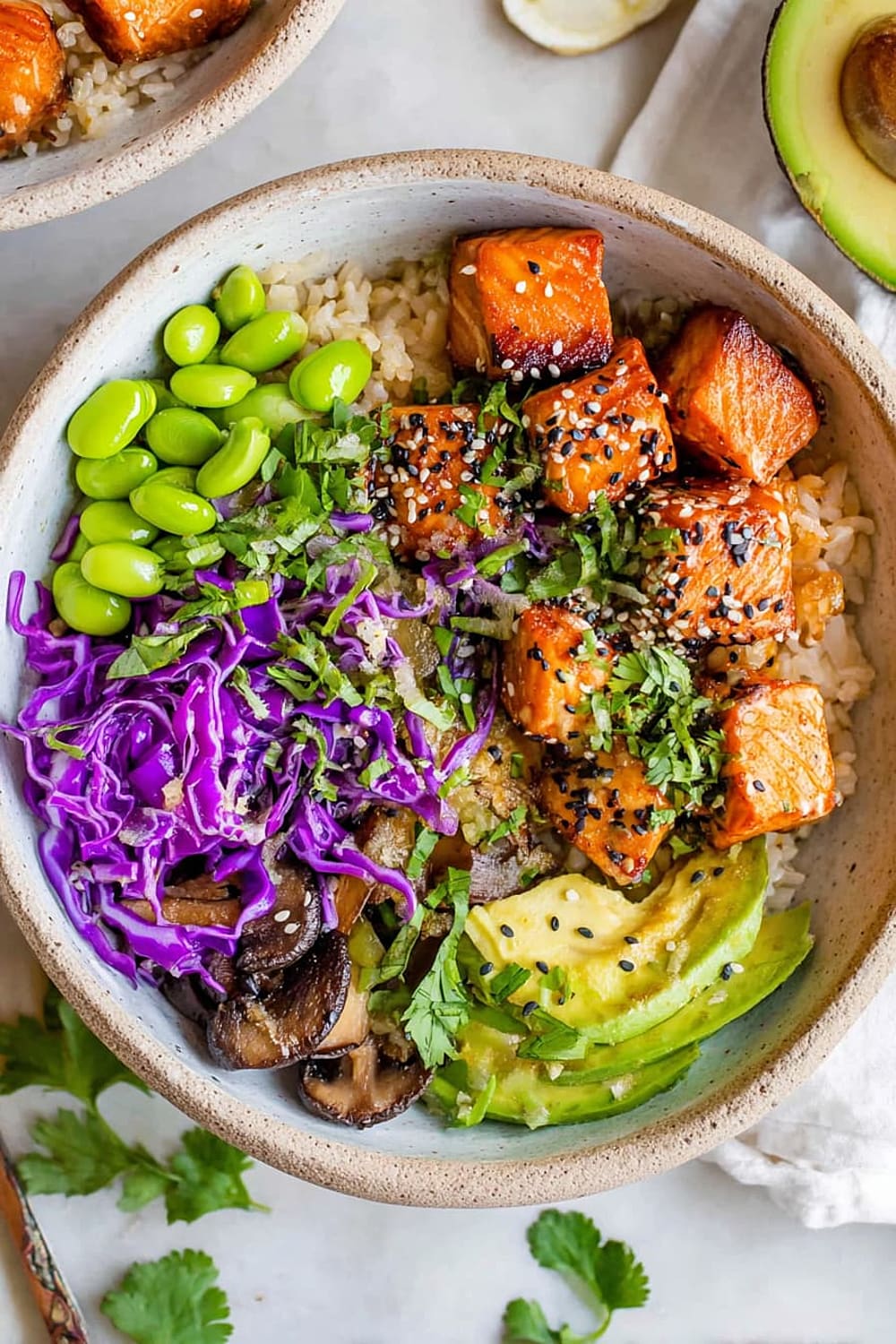
This miso salmon bowl proves that eating well doesn’t require complicated techniques or exotic ingredients – just quality components treated with respect and combined thoughtfully. The result is a meal that satisfies both your nutritional needs and your desire for something that tastes absolutely incredible, making healthy eating feel like the delicious choice it should always be.